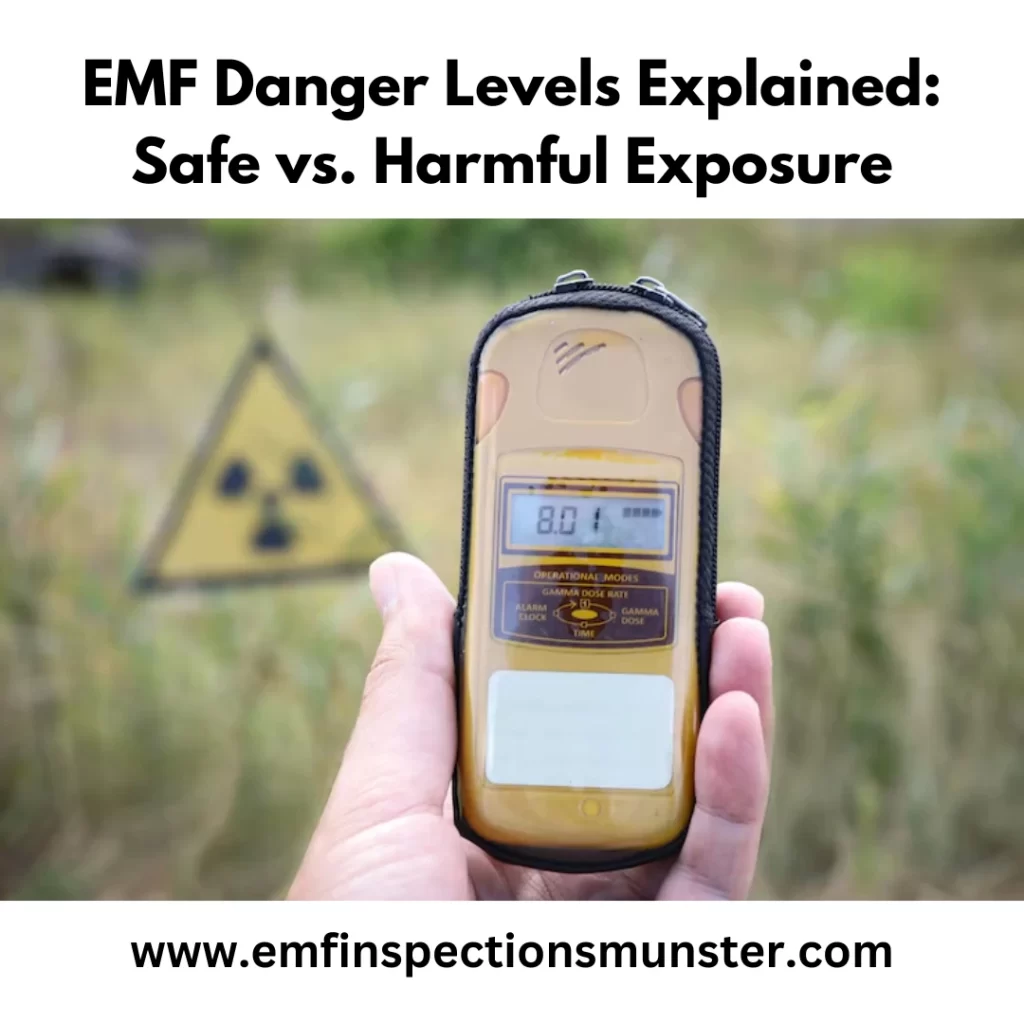Electromagnetic fields (EMFs) are all around us. From household appliances to mobile phones and Wi-Fi routers, EMFs play a crucial role in modern life. But how safe are they? Understanding EMF danger levels is essential to differentiate between safe and harmful exposure. While some EMFs are harmless, prolonged or excessive exposure to high levels of EMFs may pose health risks.
What Are Electromagnetic Fields?
Electrically charged objects generate invisible areas of energy known as electromagnetic fields (EMFs). These fields are categorized into two main types: ionizing and non-ionizing radiation.
- Ionizing Radiation: This type includes high-frequency radiation, such as X-rays and gamma rays, which have enough energy to remove electrons from atoms. This process can damage DNA and potentially lead to cancer.
- Non-Ionizing Radiation: This includes lower-frequency EMFs, such as those emitted by power lines, household appliances, and wireless devices. These EMFs do not have enough energy to ionize atoms but can still interact with biological tissues.
Sources of EMF Exposure
We are bombarded with EMFs from a variety of sources during our daily lives. Some of the most common sources include:
- Power Lines: Electrical transmission lines emit low-frequency EMFs.
- Household Appliances: Refrigerators, hairdryers, televisions, and microwaves generate EMFs when in use.
- Wireless Devices: Cell phones, Wi-Fi routers, Bluetooth gadgets, and smart meters emit radiofrequency (RF) EMFs.
- Medical Equipment: X-rays, MRIs, and radiation therapy devices use ionizing radiation for diagnostic and treatment purposes.
- Industrial and Occupational Sources: Some workers, such as electricians and radio technicians, are exposed to higher EMF danger levels in their workplaces.
Understanding EMF Danger Levels
Determining the safe versus harmful levels of EMF exposure requires an understanding of established safety guidelines and scientific research.
International EMF Safety Standards
Several health organizations have set EMF exposure limits to ensure public safety. Some of these include:
- International Commission on Non-Ionizing Radiation Protection (ICNIRP): This organization provides safety guidelines to prevent adverse health effects from EMF exposure.
- Federal Communications Commission (FCC): In the U.S., the FCC regulates EMF emissions and enforces safety limits for wireless communication devices.
- World Health Organization (WHO): WHO monitors research on EMF exposure and evaluates potential health risks.
Safe vs. Harmful EMF Exposure Levels
- Low-Level EMFs (Safe Exposure): These include exposure from household appliances and wireless devices that comply with safety regulations. Studies suggest that these low levels do not cause harmful biological effects.
- Moderate-Level EMFs (Potentially Harmful with Long-Term Exposure): These include exposure from prolonged cell phone use and living near power lines. Research has suggested potential links between long-term exposure and certain health conditions.
- High-Level EMFs (Dangerous Exposure): Ionizing radiation, such as X-rays and gamma rays, is well-documented to cause cellular damage and increase the risk of cancer. Occupational exposure to high-frequency EMFs without protective measures can also be harmful.
Health Risks of EMF Exposure
Scientific studies have explored potential health risks associated with EMF exposure. While research is ongoing, here are some concerns that have been raised:
Cancer Risk
The potential link between EMFs and cancer has been widely debated. In 2011, the International Agency for Research on Cancer (IARC), a part of WHO, classified radiofrequency EMFs as “possibly carcinogenic to humans” based on limited evidence linking cell phone radiation to glioma, a type of brain cancer.
Electromagnetic Hypersensitivity (EHS)
Some individuals report symptoms such as headaches, fatigue, dizziness, and sleep disturbances that they attribute to EMF exposure. While scientific studies have not found conclusive evidence to support a causal relationship, EHS remains a topic of ongoing research.
Impact on Sleep and Brain Function
Exposure to EMFs, especially from wireless devices, may interfere with melatonin production and disrupt sleep patterns. Some studies have also suggested that EMFs could affect cognitive function and memory.
Effects on the Nervous System
There is some evidence that prolonged exposure to EMFs may lead to changes in nervous system function, potentially causing stress responses, fatigue, and difficulty concentrating.
Reducing EMF Exposure
While EMF exposure is unavoidable, there are practical steps you can take to minimize potential risks:
Maintain Distance
- Keep mobile phones away from your body when not in use.
- Use speakerphone or wired headsets instead of holding your phone against your ear.
- Avoid placing computers on your lap for lengthy periods.
Limit Wireless Device Usage
- Reduce your screen time and take vacations from electronic gadgets.
- Turn off Wi-Fi routers and mobile data when not needed.
- Avoid sleeping near electronic devices, especially your smartphone.
Use Wired Connections
- Opt for wired internet connections instead of Wi-Fi when possible.
- Use wired headphones instead of Bluetooth devices.
Shielding Measures
- Consider EMF shielding products, such as radiation-blocking phone cases and anti-radiation fabrics.
- Use low-EMF lighting options, such as LED bulbs, instead of compact fluorescent lamps (CFLs).
Improve Home and Workplace Safety
- Position workstations away from high EMF sources such as electrical panels and Wi-Fi routers.
- Follow workplace safety guidelines for EMF exposure in industries where radiation levels are high.
Future Research and EMF Regulation
As technology evolves, ongoing research aims to better understand the long-term effects of EMF exposure. Regulatory agencies continue to update safety guidelines based on new scientific findings. Public awareness and education play a key role in ensuring responsible EMF use.
Conclusion
Understanding EMF danger levels is essential in today’s digital age. While low-level EMFs from everyday devices are generally considered safe, it is wise to take precautionary measures to minimize unnecessary exposure. By being mindful of our interactions with technology, we can create a balanced approach to using electronic devices while safeguarding our well-being. Ultimately, maintaining a healthy relationship with the human electromagnetic field that surrounds us is key to leading a safer and healthier life.
Frequently Asked Questions:-
1. What are the common sources of EMF exposure in daily life?
- EMFs are emitted by various sources, including power lines, household appliances (like microwaves and refrigerators), wireless devices (such as cell phones, Wi-Fi routers, and Bluetooth gadgets), medical equipment (X-rays and MRIs), and industrial machinery.
2. Can EMFs from mobile phones and Wi-Fi routers cause health problems?
- While research is ongoing, some studies suggest prolonged exposure to radiofrequency (RF) EMFs from mobile phones and Wi-Fi routers may be linked to potential health risks such as sleep disturbances, headaches, and in some cases, increased cancer risk. However, regulatory agencies like WHO and ICNIRP set safety guidelines to minimize potential risks.
3. How can I reduce my exposure to EMFs at home?
- To minimize EMF exposure, keep electronic devices away from your body, use speakerphone or wired headsets, turn off Wi-Fi and mobile data when not needed, avoid sleeping near your smartphone, and use wired internet connections instead of Wi-Fi where possible.
4. Is electromagnetic hypersensitivity (EHS) a real medical condition?
- EHS refers to symptoms like headaches, fatigue, and dizziness that some individuals attribute to EMF exposure. While there is no conclusive scientific evidence linking EHS to EMFs, ongoing research continues to explore the condition.
5. Are EMF shielding products effective in reducing exposure?
- EMF shielding products such as radiation-blocking phone cases, anti-radiation fabrics, and low-EMF lighting, may help reduce exposure. However, their effectiveness varies, and the best way to minimize exposure is to follow practical precautions, such as limiting device usage and maintaining distance from EMF sources.


